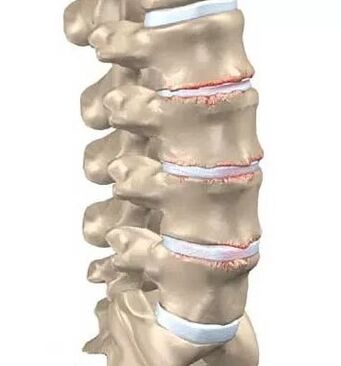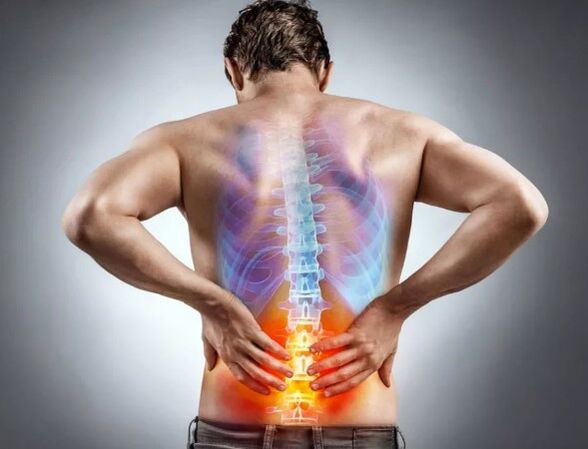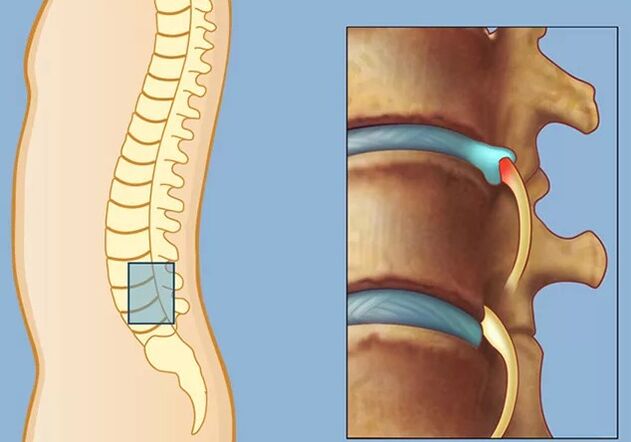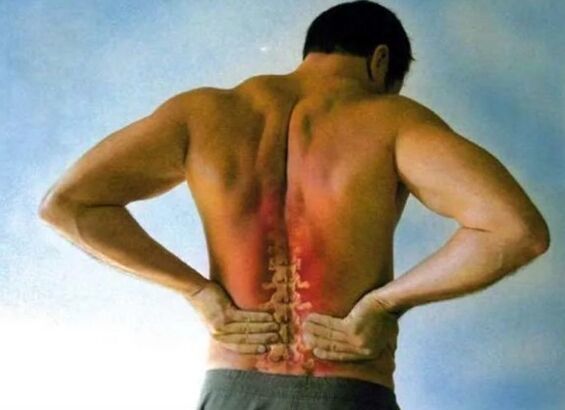Osteochondrosis of the lumbar spine is a disease that is a special form of spine damage. Patients with such disease complain of rapid fatigue, back pain, legs, which causes limiting motor activity. With osteochondrose, there is a deformation of intervertebral disks, there is a reduction in their height, dystrophy and pine growth steps. When diagnosed on the radiography, discons are clearly visible.

Deformation of crunchal tissues during the development of osteochondrose is a complex process, including biochemical and vascular changes. First of all, the fibrous ring was destroyed, as a result is introduced to the Pustine. As a result, the fibrous ring is torn, and the hernia is formed on the disc. In this case, the lower glow and segment of a lower lover is subjected to the highest load. The hernia disk, squeezing the spinal cord or its roots, becomes a cause of pain in the back, which suits the leg.
The most powerful sciatic nerve in the human body is formed by the sacral roots of the spinal cord. They are, as well as lower pets, are irritated by osteochondrose. From the Latin name of the sciatic nerve, in this regard, the second name of the disease was formed - Ishias.
Due to the violation of the structure of the cartilage fabric, interverters, which are special crispy structures, they can no longer fulfill all their functions in full. This leads to loss of spinal flexibility and mobility. Processes, which in the initial stages of the disease affect only interverters, is gradually applied to the vertebrae itself.
Discogenic radiocolite, which is considered one of the most common sense symptoms, is located in almost every Petioy person older than 30 in the world. At risk, working age people are most often at risk. Osteochondrosis deprives the ability to deal with active activities and often causes disability.
Symptoms of lumbar osteochondrose
The main symptoms of lumbar osteochondrosis are strong back pain. However, in addition to this sign there are a number of others. So, patients who suffer from this disease get tired quickly, complain of headaches, fatigue and irritability. The discomfort in the back does not allow you to choose a handsome sleeping position so that the body cannot completely relax and recover after the end of the day. The loss of power is forcing the patient to minimize physical activity and avoids pain. This leads to the fact that over time cannot be able to perform even simple actions, for example, they provide their household needs.

Problems in the work of the genitourian system can be one of the symptoms of lumbar osteochondrose. Appear in the form of pain in the kidney area. In patients with osteochondrose, urination is disturbed, an unexpected occurrence of discomfort is possible. This leads to the instability of the vertebrae, which is not fixed due to deformation with intervebral discs. The spine load causes the displacement of the lumbar department from the cross when it is exposed to force weight. Such a process leads to damage to internal bodies, problems in their work. In women, ovaries, additives and uterus are most often suffering, and the potency disturbs men.
Osteochondrosis is characterized by increasing leg sensitivity, including stopping, hips and lower legs. They are cramps that can lead to full loss of pulse. The skin of the patient with osteochondrose on his feet is very dry, shell and covered goosebumps in the area of discomfort. During pain, sweat is disturbed.
All the symptoms of osteochondrose can be classified in the following groups:
Rook syndrome
Intervertebral disc thymes leads to loss of vertebral stability. After becoming mobile, they begin to annoy and squeeze blood vessels and nervous roots with sharp movements and great physical efforts. This process minimizes pain in the lumbar area, but teaching with renewed vigor where the nerve is compressed. The pain is acute and drilling is drilling. The most discomfort is expressed in a sub-centered leg, thigh, foot and buttocks. An unpleasant sensation make the patient change a walk, leaning against the opposite side of the nerve.
When the nervous roots are annoyed for a long time, their inflammation, swelling, venous stagnation and intoxication appear. Pain refers to muscles, ligaments. Most acute is in moments of physical activity, especially if it is executed without warm - immediately after sleep or sleep. The pain is often accompanied by increased sweating, which replaces the feeling of coldness.
MANIFESTATIONS OF RADICULAR SYNDROMA also includes tingling, numbness and loss of sensitivity. Muscles lose their tone, so patients are unable to endure long-term physical activity, for example, lower and lift stairs, get tired quickly. The functions of the pelvis are disturbed in particularly difficult cases. In this case, even the appearance of paralysis and paresis is possible.
Ischemic syndrome
There are blood vessels near nerve roots, which are compressed during deformation. At the first phases of osteochondrose development, the arteries are periodically compressed, but then Spasm acquires a permanent character. In this case, "Glavčani Lome" appears, the patient often has to stop and rest for a long walk.
Final blood vessels lead to the fact that the paulics are not receiving the necessary nutrients. This causes pain on the inside of the hips, perineum, in the buttocks to their paralysis.
Vertebra syndrome

Under the influence of pain, ischemic and radical syndrome, the skeleton of the patient with osteochondrose is deformed. The person begins to bite, he has a pelvis and spine, weak muscles, atrophy. All these changes affect the stroke, which adapts depending on the area of pain, becomes tense and uncertain. Gradually, the entire muscular and bone system is exposed to osteochondrose, and intervertebral discs are still collected.
Syndrome of pain (pain with lumbar osteochondrose)
An unpleasant sensation and discomfort in the back are the main symptoms for osteochondrose. Nature and strength pain change depending on the disease development phase.
Initially, he feels only in the lumbar region in the time of increased voltage of joints, muscles and ligaments, ie when performing physical effort. It can also be painfully painful. But with the development of osteochondrose, acute pain or a shift occurs even with sneezing, coughing.
Palpation, as a rule, allows you to specify the seal in the muscles. The attack of pain can last a few days, and all that time the patient must observe the rest to diminish unpleasant sensations in the back. Any sharp movements, lifting weight causes discomfort.
Causes of lumbar osteochondrose
The following main reasons for the development of lumbar osteochondrosis differs:
- Uneven load on your spine. According to experts, osteochondrose is characteristic of a person as a biological species, because it is largely due to its lifestyle and immedia. The need to maintain the position of the body in a certain position requires a constant tension of the muscle-bone system. The optimal load on the spine will be in a standing position. In a lying position with your back, it is minimal, on the side - a little more. But in a sitting position, the load on the lumbar spine increases significantly. The slope of the body forward creates an additional voltage for the front edge of the vertebral and the spinal column. It is therefore recommended to periodically change the position of the body, giving muscles to relax and move the load on your spine and hold the back.
- Hypodynamia. The sedentary lifestyle, the use of cars and public transport, consuming a large amount of time for a computer and TV - all that contributes to the development of the problem with vertebrae, including osteochondrose. Lacking a significant part of the population in motor activity. The passive lifestyle leads to the fact that the muscular and bone system weakens. In a sitting position, the spine is subject to maximum load, it becomes the cause of cartridge tissue and as a result, osteochondrose of the lumbar region. Therefore, it is so important to get up to occasionally and perform a set of exercises. When a person spends a significant part of the time in a bent position, bending muscles stretch and lose the tone.
- Too high physical activity. Increased motor activity, such as its shortage, can also cause osteochondrose. Back pain often cares for athletes dealing with a difficult athletics. This sport requires lifting weight, which creates additional tension for rear muscles and causes the creation of intervertebral tipper.
- Incorrect posture. In the curved position of the spine, the load on it is distributed unevenly, which leads to deformation of intervertebral disks. The same impact affects an improper walk. People and older people fall into a risk group, because over time, interverters are becoming less elastic, lose mobility and are easier to be damaged.
- Bone system malfunctions and genetic predispositions, injuries and infectious diseases. Osteochondrosis As a rule, causes congenital problems with the musculos-bone system. In addition, the cause of the disease can be a natural fragility of cartilage. Osteochondrosis is also developed as a complication after various spine damage, osteomyelitis, tuberculosis.
- Flat feet. In patients who suffer from flat feet, the footpath does not perform depreciation functions, as is in normal condition. Therefore, when moving the entire burden, it will be taken over on intervebrelal discs, as a result, their fast spending occurs.
- Excess weight. Additional kilograms are a source of additional load on the heart and a muscle system, including spine. According to statistics, people with excess weight are more sensitive to different diseases.
- Inflammatory processes in the body. Development of osteochondrosis facilitates factors such as hormonal changes, spine joints, for example, rheumatoid arthritis, impaired endocrine, digestive and cardiovascular system.
- Life. Many patients do not pay due attention to their health: they move a little, don't sleep enough, eating wrong. This leads to increased fatigue, a violation of the psycho -emotional state, stress. All this makes the body very vulnerable and contributes to the development of lumbar osteochondrose.

Degree of osteochondrose lumbar
There are 4 degrees of osteochondrose lumbar:
- Cracks appear within a fibrous ring that are filled with the substance from the jet core, which causes irritation. At this stage, the deformation of intervertebral discs is poorly expressed by manifests in the form of reflex-booleey symptoms. The patient can complain about the pain in the heart, the lower back. In the back of the cause of discomfort, sharp movements becomes weight lifting. Depending on the character, 2 types of pain: lumbalia and lumbago. In the first case, it is stable, and in a second occurs suddenly;
- Destruction of the fibrous ring is continued. However, there is a decrease in the gap between vertebrae, the nervous ends are shot. At this stage, the phenomenon is characterized as a pseudospondylolistesis of the lumbar region. This is the name of the process of displacing vertebral compared to seven others, which leads to tightening nerve endings and causes pain. The spine is characterized by unusual mobility. With the osteochondrose of the second degree, patients complain about the pronounced discomfort in the back, in the lumbar area, warmth and cold feel alternately. The pain is manifested by seizures, during which appear on the skin on the skin and intensifying intensification;
- The own ring is finally torn and the core jacket is grip out. InterseverTebral Hernia appears. The solid core in the area of the spinal channel leads to the grip of the vessel and the roots of spinal nerves.
Spine deformation forms lordoz, kyphosis or scoliosis. With Lordosh, the spine turns forward. Such a violation of the normal position greatly complicates the work of internal bodies and their systems. With the cyfose, the upper spine is curved, and the feeling of bent in advanced cases appears. Side curvature is manifested in the form of scoliosis. When the patient suffers from osteochondrose with such a curved vertebrate reliance, asymmetry becomes noticeable thanks to the protruding blade or rib;
- The last phase of osteochondrose is the most dangerous, because the spine is finally deformed, which makes the motorcycle completely impossible. The growth of bones are becoming noticeable on the radiograph. Although pain does not bother the patient for a while, this does not indicate improvement. 4 Degree of osteochondrosis is most often ended with disabilities.






































